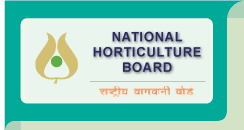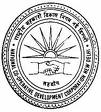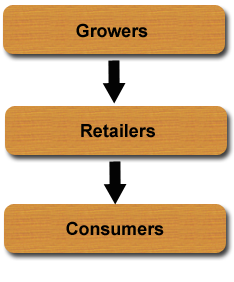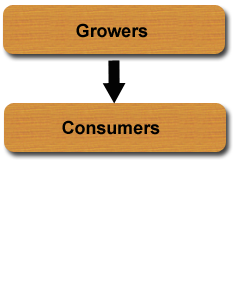Marketing
Domestic market
Export
Export Standarads
Marketing information sources
Codex alimentarius
Domestic Market
Distribution of produce
Marketing channels
Regulated markets in TN
Catchment areas of market
Concentrated pockets of banana in india
Distribution of Produce
Distribution of produce from primary to terminal market
-
Banana produced in Southern states namely Andhra Pradesh, Kerala, Karnataka, and Tamil Nadu reaches major markets of Bangalore, Mysore, Chennai, Madurai, Hyderabad,Vishakhapatnam and Thiruvananthapuram, and is consumed within southern region.
-
Banana grown in the states of Maharashtra, Madhya Pradesh and Gujarat reaches North India in the markets of Bhopal, Jaipur, Lucknow and Delhi from where it is distributed in northern states like Himachal Pradesh, Uttarakhand, Jammu & Kashmir, Punjab and Haryana.
-
Bananas produced in West Bengal and Orissa is distributed in markets of Patna, Ranchi,Raipur, Kolkata, Bhubaneshwar etc. and is consumed in these states.
-
The banana grown in North- Eastern states is consumed in this region itself.
Marketing channels in Tamil Nadu


Channel 3
Channel 4
Regulated Markets
List of regulated markets of banana in tamilnadu:
1 |
Thottiyam |
Thottiyam 621 215. |
2 |
Kattuputhur |
Kattuputhur 621 207. |
3 |
Solakadu |
Solakadu, Kollimalai, Namakkal Taluk. |
4 |
Melur |
Trichy Road, Uzhavar Santhai Complex, Melur 6250106 |
Catchment areas of markets of banana in leading states:
States |
Districts (Market) |
Blocks |
Tamil Nadu |
Thiruchirapalli |
Thuraiyur, Thottiyam, Musiri, Manachanallur, Lalgudi,Srirangam |
Coimbatore |
Mettuppalaiyam,Avinashi,Tiruppur,Palladam,Udumallaip |
|
Theni |
Periyakulam, Andipatti, Uttammapalayam, |
|
Karnataka |
Uttar Kannad |
Maliyal,Mundgod,Yellapur,Sirsi,Siddapur,Bhatkal,Ankol |
Udupi |
Kundapura,Kokkaroni,Karkal,Goligudelej,Chittur,Harma |
|
Maharashtra |
Jalgaon |
Chopda, Yaval, Raver, Edalbad, Bhusawal, Jamner, |
Dhule |
Shirpur, Sindhkheda, Sakri, Nardana, Boradi, |
|
Buldhana |
Malkapur, Khamgaon, Mehekar, Chikhli |
|
Andhra Pradesh |
Guntur |
Tangeda,Dachepalle,Piduguralla,Sattenapalie,Vinkoda,Po |
Vijayanagram |
Parvatipuram,Bobblli,Gajapatinagaram,Chipurupalla,Salu |
|
Prakasham |
Erragondapalem, Markopur, Giddalur, Tarlupadu, Podile, |
|
Gujarat |
Surat |
Mangrol,Umarwada,Mandvi,Vyara,Valod,Mahuva,Palsan |
Anand |
Sojitra,Sarsa,Sunav,Undel,Lunej,Ras,Kantha,Morai,Vadta |
|
Madhya Pradesh |
Khandwa |
Harsud, Pandhana, Nepanagar, Burhanpur |
Dhar |
Badnawar, Sardarpur, Gandhqwani, Manaawr, Kukshi, |
|
Badwani |
Thikri, Rajpur, Newali, Pansemal, Sendwa |
Concentrated pockets of banana in India:
State |
Districts |
Tamil Nadu |
Thiruchirapalli, Theni, Coimbatore, Erode , Pudukottai, Vellore, Karur, Dindigul, Thanjavur, Nammakal, Madurai |
Karnataka |
Shimoga, Dakshin Kannada, Tumkur, Bangalore,Udupi, Uttara Kannada,Belgaum, Chickmangalur, Hassan, Mandya |
Maharashtra |
Jalgaon, Dhule, Buldhana |
Andhra Pradesh |
Cudappa, Guntur, East Godavari, West Godavari, Vijayanagram, |
Assam |
Barpeta, Kamrup, Nalbari, Nagaon, Sonitpur. |
Gujarat |
Surat, Anand, Bharuch, Narmada, Vadodara |
Export
Tamilnadu
Karnataka
Kerala
Export Standard
1. Classes
Bananas are classified in three classes
Extra Class
Class I
Class II
Extra Class
-
Bananas in this class must be of superior quality. They must be characteristic of the variety and/or commercial type.
-
The fingers must be free of defects, with the exception of very slight superficial defects, provided these do not affect the general appearance of the produce, the quality, the keeping quality and presentation in the package.
Class i
-
Bananas in this class must be of good quality. They must be characteristic of the variety.
-
The following slight defects of the fingers, however, may be allowed, provided these do not affect the general appearance of the produce, the quality, the keeping quality and presentation in the package.
- slight defects in shape and colour
- slight skin defects due to rubbing and other superficial defects not exceeding 2cm² of the total surface area
Class ii
-
This class includes bananas which do not qualify for inclusion in the higher classes, but satisfy the minimum requirements specified in Section 2.1 above. The following defects, however, may be allowed, provided the bananas retain their essential characteristics as regards the quality, the keeping quality and presentation.
-
Defects in shape and colour, provided the product retains the normal characteristics of banana.
-
Skin defects due to scraping,scabs,rubbing,blemishes or other causes not exceeding 4 cm² of the total surface area . The defects most not , in any case, affect the flesh of the fruit.
2.Contaminants & Hygiene
CONTAMINANTS
Heavy Metals:
Bananas shall comply with those maximum levels for heavy metals established by the Codex Alimentarius Commission for this commodity.
Pesticide residues :
Bananas shall comply with those maximum pesticide residue limits established by the Codex Alimentarius Commission for this commodity.
HYGIENE
-
It is recommended that the produce covered by the provisions of this Standard be prepared and handled in accordance with the appropriate sections of the Recommended International Code of Practice – General Principles of Food Hygiene (CAC/RCP 1-1969, Rev. 4-2003), Code of Hygienic Practice for Fresh Fruits and Vegetables (CAC/RCP 53-2003), and other relevant Codex texts such as Codes of Hygienic Practice and Codes of Practice.
-
The produce should comply with any microbiological criteria established in accordance with the Principles for the Establishment and Application of Microbiological Criteria for Foods (CAC/GL 21-1997)
3.Documents required for Export
a)Documents related to goods
a) Invoice b) Packing List c) Certificate of origin
b)Documents related to shipment
a) Mate Receipt b) Shipping Bill c) Bill of handing d) Airway Bill
c)Documents related to Payment
a) Letter of Credit (L/C) b) Bill of Exchange
d)Documents related to quality of goods
a) Phytosanitary Certificate b) GLOBALGAP Certification c) Health Certificate
e) Organic Certification
-
Certificate indicating material produce is based on organic farming.
f) Documents related to Foreign Exchange Regulations
GR Form : Documents required by RBI which assures to RBI that the exporter will realize the proceeds of goods within 180 days from the date of Shipment.
g) Other Document
Bank Realization Certification (BRC): This is the advice given by Foreign Exchange Bank after the realization of money from Importer"
4.List of Banana cultivars for export
Groups |
Subgroups |
Maincultivar |
AA |
Sweet - Fig |
Sweet fig,Pisang Mas,Amas Date,Bocadilo. |
AB |
Ney Poovan |
Ney Poovan,Safed Velchi. |
AAA |
Cavendish |
Dwarf Cavendish,Giant Cavendish,Lacatan,Poyo(Robusta),Williams, Americani,Valery,Arvis. |
Gros Michel |
Gros Michel,Highgate |
|
Pink Fig |
Pink Fig, Green Pink Fig. |
|
Lbota |
|
|
AAB |
Apple Fig |
Apple Fig,Silk. |
Pome |
Pacovan,Parata Ana. |
|
Mysore |
Mysore, Pisang Ceylan, Gorolo. |
5.Marking or labelling
CONSUMER PACKAGES :
-
In addition to the requirements of the Codex General Standard for the Labelling of Prepackaged Foods (CODEX STAN 1-1985, Rev. 1-1991), the following specific provisions apply
Nature of Produce :
-
If the produce is not visible from the outside, each package shall be labelled as to the name of the produce and may be labelled as to name of the variety.
Non-Retail Containers :
-
Each package must bear the following particulars, in letters grouped on the same side, legibly and indelibly marked, and visible from the outside, or in the documents accompanying the shipment.
Identification :
-
Name and address of exporter, packer and/or dispatcher. Identification code (optional).
Nature of Produce :
-
Name of the produce if the contents are not visible from the outside. Name of the variety or commercial type (optional).
Origin of Produce :
-
Country of origin and, optionally, district where grown or national, regional or local place name.
Commercial Identification :
-
Bananas in fingers (when appropriate);
-
Class;
-
Net weight (optional) Official Inspection Mark (optional)
6.Provisions concerning Presentations
UNIFORMITY
The contents of each package must be uniform and contain only bananas of the same origin, variety, and quality. The visible part of the contents of the package must be representative of the entire contents.
PACKAGING
-
Bananas must be packed in such a way as to protect the produce properly. The materials used inside the package must be new1, clean, and of a quality such as to avoid causing any external or internal damage to the produce. The use of materials, particularly of paper or stamps bearing trade specifications is allowed, provided the printing or labelling has been done with non-toxic ink or glue.
-
Bananas shall be packed in each container in compliance with the Recommended International Code of Practice for Packaging and Transport of Fresh Fruits and Vegetables (CAC/RCP 44-1995, Amd. 1-2004).
DESCRIPTION OF CONTAINERS
-
The containers shall meet the quality, hygiene, ventilation and resistance characteristics to ensure suitable handling, shipping and preserving of the bananas. Packages must be free of all foreign matter and smell.
PRESENTATION
-
The bananas must be presented in hands and clusters (parts of hands) of at least four fingers. Bananas may also be presented as single fingers;
-
Clusters with no more than two missing fingers are allowed, provided the stalk is not torn but cleanly cut, without damage to the neighboring fingers;
-
Not more than one cluster of three fingers with the same characteristics as the other fruit in the package may be present per row.
7.Provisions concerning Quality
In all classes, subject to the special provisions for each class and the tolerances allowed,the bananas must be:
-
whole (taking the finger as the reference);
-
sound, produce affected by rotting or deterioration such as to make it unfit for consumption is excluded;
-
clean, practically free of any visible foreign matter;
-
practically free of pests affecting the general appearance of the produce; - practically free of damage caused by pests;
-
free of abnormal external moisture, excluding condensation following removal from cold storage, and bananas packed under modified atmosphere conditions;
-
free of any foreign smell and/or taste;
-
firm;
-
free of damage caused by low temperatures;
-
practically free of bruises;
-
free of malformation or abnormal curvature of the fingers;
-
with pistils removed;- with the stalk intact, without bending, fungal damage or dessication.
In addition, hands and clusters must include:
-
a sufficient portion of the crown of normal colouring, sound and free of fungal contamination;
-
a cleanly cut crown, not bevelled or torn, with no stalk fragments.
The development and condition of the bananas must be such as to enable them:
-
to reach the appropriate stage of physiological maturity corresponding to the particularcharacteristics of the variety;
-
to withstand transport and handling; and to arrive in satisfactory condition at the place of destination in order to ripensatisfactorily.
8.Provisions concerning sizing :
For the purposes of sizing bananas of the Gros Michel and Cavendish sub-groups, the length of the fingers is determined along the outside curve from the blossom end to the base of the pedicel where the edible pulp ends and the diameter is defined as the thickness of a transverse section between the lateral faces. The reference fruit for measurement of the length and grade is:
-
for hands, the median finger on the outer row of the hand;
-
for clusters, the finger next to the cut section of the hand, on the outer row of the cluster. The minimum length should not be less than 14.0 cm and the minimum grade not less than 2.7 cm.
9.Provisions concerning tolerances :
Tolerances in respect of quality and size shall be allowed for produce not satisfying the requirements of the class indicated.
QUALITY(TOLERANCES)
Extra Class
Five percent by number or weight of bananas not satisfying the requirements of the class,but meeting those of Class I or, exceptionally, coming within the tolerances of that class.
Class I :
-
Ten percent by number or weight of bananas not satisfying the requirements of the class, but meeting those of Class II or, exceptionally, coming within the tolerances of that class.
Class II :
-
Ten percent by number or weight of bananas satisfying neither the requirements of the class nor the minimum requirements, with the exception of produce affected by rotting, major imperfections or any other deterioration rendering it unfit for consumption.
Size(TOLERANCES):
-
For all classes, 10% by number or weight of bananas not satisfying the requirements as regards sizing, but falling within the size immediately above or below those indicated in Section 3.
Marketing Information Sources
Introduction
Marketing information helps the farmers in taking decisions in marketing their produce. The farmers are not able to know about the prices prevailing in the markets, as the market committees are able to disseminate information only in respect of their own markets. Therefore, farmers are left with no alternative but to dispose their produce in the nearest market, even at uneconomic prices. Market information is equally needed by other market participants in arriving at optimal trading decisions.
In order to improve the present agricultural marketing information system in the country, Directorate of Marketing & Inspection(DMI), Ministry of agriculure has launched scheme. AGMARKNET envisages linking all important agricultural produce markets in the country, the State Agricultural Marketing Boards & Directorates and DMI for effective information exchange. AGMARKNET has led to a national-wide information network for speedy collection and diffusion of market information, computerization of market related information such as market fees, market charges, etc., ensuring regularity and reliability of data and increasing the efficiency in agricultural markets
Organisations Providing Marketing Services
-
AGMARKNET
-
Dynamic Market Information (DMI)
-
Agricultural and Processed Food Products Export Development Authority (APEDA)
-
National Agricultural Cooperative Marketing Federation of India Ltd.(NAFED)
-
National Hortiucltural Board (NHB)
-
SAFAL Market
-
Director General of Foreign Trade, (DGFT)
-
Director General of Commercial Intelligence & Statistics (DGCIS)
-
National Co-operative Development Corporation (NCDC)
AGMARKNET
|
 |
Activtities:
-
AGMARKNET database accrue to the farmers, as they have choices to sell their produce in the nearest market at remunerative prices.
-
Nationwide market information for wholesale produce.
-
Project supported by various Departments and State Boards of Agricultural Marketing
-
Access mainly through the Internet
-
Information dissemination progressively through local languages
-
Computer facilities at the markets
-
Software for download - Daily market prices
-
Information collected by nodes in the various markets
-
Weekly trends
-
Information on loans, policies and regulations
-
Bypass middlemen
-
Data Dissemination through NGOs, SHGs, KVKs, GISTNIC, Cooperatives etc
Address:
AGMARKNET Project Directorate
Agricultural Informatics Division
National Informatics Centre
A-Block, CGO Complex, New Delhi 110 003
Tel: +91-11-24367712,24305669,24305763,24305692, 0129-2415954
Web site: http://www.agmarknet.nic.in
Dynamic Market Information
Dynamic Market Information (DMI) Service is one such initiative to provide accurate market related information to farmers and related stakeholders on daily basis. |
 |
Dynamic Market Information Service for Agri – Horti Produces through www.indg.in
Credible and timely information plays a crucial role in agricultural marketing, particularly for perishables. Due to lack of proper market information channel and interference of middle man, the farmers have been exploited often and forced to sell their produce at lower price in their nearby market. The harvested produce can be sold at a premium price information of the nearest alternative markets is disseminated to farmers on demand and daily basis. They can make better decision to harvest the produce at right time and send their consignment to particular market where the market price is higher for his/her produce. The power of information and mobile technology is making things possible to get the required information at required time. Dynamic Market Information (DMI) Service is one such initiative to provide accurate market related information to farmers and related stakeholders on daily basis
Contact Details :
Director (SAMETI) Directorate of Extension Education ,Tamil Nadu Agricultural University
Coimbatore – 641003. Phone: 0422 – 6611233 / 6611383 E-mail: portal@tnau.ac.in Website:www.agritech.tnau.ac.in
India Development Gateway (InDG)
Centre for Development of Advanced Computing (C-DAC), Jawaharlal Nehru Technical University (JNTU) Campus,
Kukatpally, Hyderabad – 500085, Phone No:040 – 213150115 E-mail: indg@cdac.in
For further details visit www.indg.in/india/market_information
Agricultural and Processed Food Products Export Development Authority (APEDA)
The Agricultural and Processed Food Products Export Development Authority (APEDA) was established by the Government of India under the Agricultural and Processed Food Products Export Development Authority Act passed by the Parliament in December, 1985. |
 |
Functions
-
Development of industries or otherwise for undertaking surveys and feasibility studies, participation in enquiry capital through joint ventures and other reliefs and subsidy schemes;
-
Registration of persons as exporters of the scheduled products on payment of such fees as may be prescribed;
-
Fixing of standards and specifications for the scheduled products for the purpose of exports;
-
Carrying out inspection of meat and meat products in slaughter houses, processing plants, storage premises, conveyances or other places where such products are kept or handled for the purpose of ensuring the quality of such products;
-
Improving of packaging of the Scheduled products;
-
Improving of marketing of the Scheduled products outside India;
-
Promotion of export oriented production and development of the Scheduled products;
-
Collection of statistics from the owners of factories or establishments engaged in the production, processing, packaging, marketing or export of the scheduled products or from such other persons as may be prescribed on any matter relating to the scheduled products and publication of the statistics so collected or of any portions thereof or extracts therefrom;
-
Training in various aspects of the industries connected with the scheduled products
APEDA is mandated with the responsibility of export promotion and development of the following scheduled products:
-
Fruits, Vegetables and their Products.
-
Meat and Meat Products.
-
Poultry and Poultry Products.
-
Dairy Products.
-
Confectionery, Biscuits and Bakery Products.
-
Honey, Jaggery and Sugar Products.
-
Cocoa and its products, chocolates of all kinds.
-
Alcoholic and Non-Alcoholic Beverages.
-
Cereal and Cereal Products.
-
Groundnuts, Peanuts and Walnuts.
-
Pickles, Papads and Chutneys.
-
Guar Gum.
-
Floriculture and Floriculture Products
-
Herbal and Medicinal Plants
Contact
Agricultural & Processed Food Products Export Development Authority
(Ministry of Commerce & Industry, Govt. of India),
NCUI Building 3, Siri Institutional Area, August Kranti Marg, New Delhi - 110 016
Phone : 91-11-26513204, 26514572, 26534186
Fax : 91-11-26526187
http://www.apeda.gov.in
National Agricultural Cooperative Marketing Federation of India Ltd.(NAFED)
National Agricultural Cooperative Marketing Federation of India Ltd.(NAFED) was established on the auspicious day of Gandhi Jayanti on 2nd October 1958. Nafed is registered under the Multi State Co-operative Societies Act. Nafed was setup with the object to promote Co-operative marketing of Agricultural Produce to benefit the farmers. Agricultural farmers are the main members of Nafed, who have the authority to say in the form of members of the General Body in the working of Nafed. |
 |
Functions
-
A nation level farmers cooperative marketing organisation
-
Provides remunerative prices to framer for their produce and ensures timely payment
-
Promotes cooperative marketing of agricultural produce
-
Bridges the gap between the producer and consumer
-
Stabilizes the prices of essential commodities
-
provides marketing assistance to the farmers by arranging disposal of their produce on consignment basis at terminal markets to enable them fetch best possible price for their produce.
-
Eggs, Fresh Fruits & Vegetables through the established cooperative network all over the country with active involvement marketing societies at mandi level.
Contact
National Agricultural Cooperative Marketing Federation of India Ltd. (NAFED)
NAFED House, Siddhartha Enclave Ring Roadm Ashram CHowk,
New Delhi- 110 014
Telephone EPAX: 011-26340019,26341810
http://www.nafed-india.com
National Horticulture Board
National Horticulture Board (NHB) was set up by the Government of India in 1984 as an autonomous society under the Societies Registration Act 1860. Board has its Head Quarter in Institutional Area, Sector 18, Gurgaon (Haryana). The Managing Director is the Principal Executive of NHB who implements various schemes under overall supervision and guidance of the Board of Directors of NHB as well as the Department of Agriculture & Co-operation, Ministry of Agriculture, Govt. of India. |
 |
Aims & Objectives of NHB Schemes
The broad aims & objectives of all the above mentioned schemes are as under:
-
Development of hi-tech commercial horticulture in identified belts
-
Development of modern post-harvest management infrastructure as integral part of area expansion projects or as common facility for cluster of projects .
-
Strengthen market information system and horticultural database
-
Development of integrated, energy efficient cold chain infrastructure for fresh horticulture produce,
-
Popularization of identified new technologies / tools / techniques for commercialization / adoption, after carrying out technology need assessment,
-
Promotion and market development of fresh horticulture produce,
-
Transfer of technology to producers/farmers and service providers, work force carrying out post harvest management including processing of fresh horticulture produce
-
Promotion of consumption of horticulture produce and products.
-
Setting up Common Facility Centers in Horticulture Parks and Agri-Export Zones.
-
Provide training and education to farmers and process industry personnel
Contact
National Horticulture Board
Ministry of Agriculture, Government of India
85, Institutional Area, Sector – 18
Gurgaon - 122015 (Haryana) Telephone 0124-2342992, 2347441, 2342989-90 FAX : 2342991
Web: http://www.nhb.gov.in
SAFAL Market
The Department of Agriculture and Cooperation, Government of India requested National Dairy Development Board to suggested system to modernize the procurement and marketing of the horticultural produce. NDDB has taken up a project in Bangalore as an alternate set up that will operate to the parallel system of marketing like Agriculture produce marketing committee. An investment of Rs.150 crores was made in to this project with the support of Government of India. |
 |
Functions
-
It facilitates the transaction between the producers and buyers through a transported auction systems
-
It integrates the producers and the retailers into the market system
-
It has 1600 tons trading capacity per day and at present they transact about 300 tons
-
Commercial cold storage facility with capacity of 10000 metric tons
-
Fruit ripening chambers for banana
-
100 spacious and well designed shops available for the buyers for their use
-
Gained a good experience in developing approaching systems for vegetable and fruit markting
-
Safal market ensures farmers a guaranteed price to farmers and avoid all sorts of exploitation of private market players.
-
The price fixed is circulated to the farmers association. Farmers produce and payment is made once in three days to farmers association by demand draft.
-
Safal market charges 3.5% of the total turnover as service charges to farmers association. Farmers association charges 1.5% as service charges to farmers.
-
the private markets the farmers are charged more than 10% as service charges apart from other exploitation practices in weightment, price fixing, transportation etc.,
-
Three types of marketing systems are there,
1.Electronic auction hall- the selling and buying take place at the press of a button. The retail and whole sale buyers participate in the auction and bid through the electronic button system
2. Safal Daily fresh outlets- there are 7 outlets in Bangalore city for the consumers to buy them directly in the shop.
3. Outstation sale
Contact
Delhi
Fruit & Vegetable Unit
Mother Dairy Fruit & Vegetable Private Limited
Mangolpuri Industrial Area Phase - I
Delhi - 110083,
India
Phone : 91-11-27902222 (30 lines)
Fax : 91-11-27915816
Director General of Foreign Trade, (DGFT)
DGFT or Directorate General of Foreign Trade is a government organization in India responsible for the formulation of exim guidelines and principles for indian importers and indian exporters of the country. Before 1991, DGFT was known as the Chief Controller of Imports & Exports (CCI&E) DGFT is responsible for implementing the foreign trade policy or Exim policy with the main objective of promoting Indian exports |
 |
Functions
-
To implement the Exim Policy or Foreign Trade Policy of India by introducing various schemes and guidelines through its network of dgft regional offices thought-out the country.
-
To Grant Exporter Importer Code Number to Indian Exporter and Importers. IEC Number is a unique 10 digit required by the traders or for the purpose of import and export in India.
-
DGFT permits or regulate Transit of Goods from India or to countries adjacent to India in accordance with the bilateral treaties between India and other countries.
-
To promote trade with neighboring countries.
-
To grant the permission of free export in Export Policy Schedule 2.
-
DGFT also play an important role in controlling DEPB Rates .
-
Setting standard input-output norms is also controlled by the DGFT.
-
Any changes or formulation or addition of new codes in ITC-HS Codes are also carried out by DGFT (Directorate General of Foreign Trade).
For more details contact
Director General of Foreign Trade, (DGFT)
Udyog Bhavan, New Delhi.
http://dgft.delhi.nic.in/
Director General of Commercial Intelligence & Statistics (DGCIS)
The Directorate General of Commercial Intelligence and Statistics (DGCI&S), Kolkata, under the Ministry of Commerce, Government of India, is the pioneer official organization for collection, compilation and dissemination of marketing related data i.e. export-import data, inter-state movement of foodgrains etc. |
 |
For more details contact
Directorate General of Commercial Intelligence and Statistics,
1, Council House Street,
Kolkata-700 001, India
Website: http://www.dgciskol.nic.in/
National Co-operative Development Corporation (NCDC)
Services
|
 |
For more details Contact:
National Co-operative Development Corporation
4, Siri Institutional Area,
Hauz Khas,
NEW DELHI - 110016
Phone: 011-26962478, 26960796, 26962379, 26569246
FAX: 0111-26962370, 26516032
Website: http://www.ncdc.in/
Codex alimentarius
Introduction
-
C O D E X A L I M E N T A R I U S is about safe, good food for everyone - everywhere.
The C O D E X A L I M E N T A R I U S international food standards, guidelines and codes of practice contribute to the safety, quality and fairness of this international food trade. Consumers can trust the safety and quality of the food products they buy and importers can trust that the food they ordered will be in accordance with their specifications. -
The Codex Alimentarius Commission, established by FAO and WHO in 1963 develops harmonised international food standards, guidelines and codes of practice to protect the health of the consumers and ensure fair trade practices in the food trade. The Commission also promotes coordination of all food standards work undertaken by international governmental and non-governmental organizations.
-
Codex standards are based on the best available science assisted by independent international risk assessment bodies or ad-hoc consultations organized by FAO and WHO. While being recommendations for voluntary application by members, Codex standards serve in many cases as a basis for national legislation.
-
Codex process - in many cases assisted by the Codex Trust Fund, which strives to finance - and train - participants from such countries to enable efficient participation. Being an active member of Codex helps countries to compete in sophisticated world markets - and to improve food safety for their own population. At the same time exporters know what importers demand, and importers are protected from substandard shipments. International governmental and non-governmental organizations can become accredited Codex observers to provide expert information, advice and assistance to the Commission.



